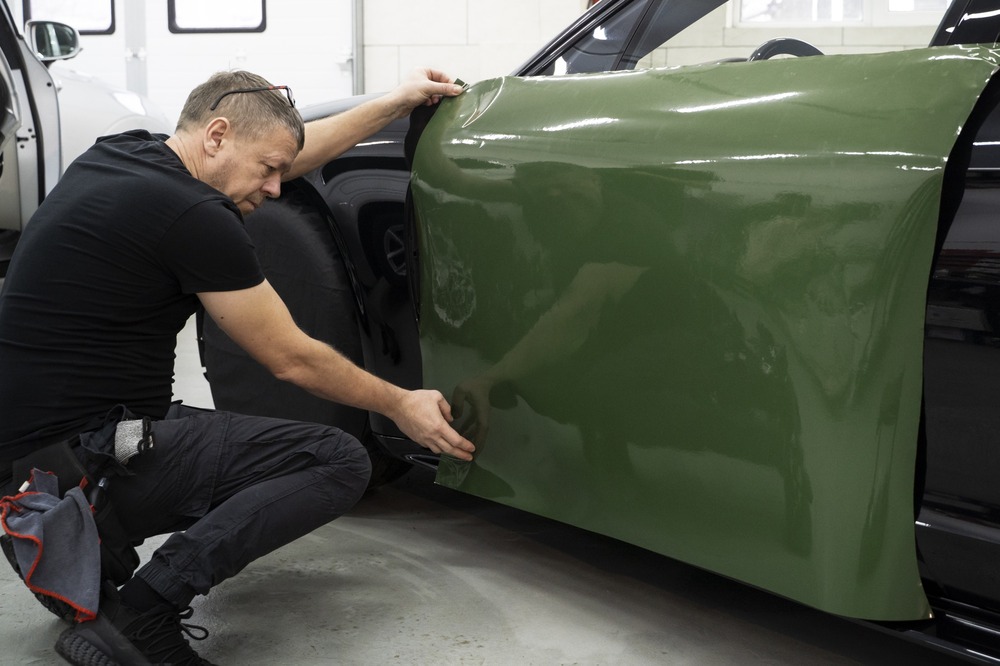Vehicle wraps can enhance the appearance of any vehicle, offering a wide range of colors, textures, and finishes. However, keeping vehicle wraps looking fresh and vibrant requires specific maintenance practices. In 2023, the passenger car segment accounted for over 54% of the revenue share in the Automotive Wrap Films Market, reflecting the high demand among car owners for both style and protection.
Here’s everything one needs to know to keep vehicle wraps in pristine condition for years.
Table of Contents

|
Key Takeaways ✔ Clean vehicle wraps at least once a week with gentle, wrap-safe soap to prevent grime buildup and maintain vibrancy. ✔ Use non-abrasive, wrap-safe products for quick touch-ups, especially in high-contact areas, to keep the wrap spotless without over-washing. ✔ Avoid drive-through car washes; handwashing provides safer, controlled cleaning for wraps and helps prevent peeling or scratching. ✔ If using a pressure washer, keep the settings low, and spray from a distance to prevent lifting or damaging the wrap’s edges. ✔ Gasoline can damage wraps if left on the surface; wipe spills immediately with a microfiber cloth to avoid staining. ✔ Steer clear of products with bleach, ammonia, or alcohol, as these can strip color and degrade the vinyl. ✔ Park in shaded areas or use a UV-resistant cover to prevent sun damage and fading from prolonged exposure. ✔ Check frequently for signs of brown or rust discoloration from pollutants, and use wrap-safe cleaners to address it promptly. ✔ Limit parking under trees or near industrial areas to reduce exposure to contaminants like sap and bird droppings. ✔ Use a wrap-safe coating for added shine and a protective barrier against UV rays, dirt, and moisture for long-term freshness. |
What is Vehicle Wrap?
Unlike paint, vehicle wraps are made of vinyl, which is more delicate and can be easily damaged if not properly cared for. The vinyl material used in wraps is susceptible to scratches, discoloration, and fading when exposed to harsh elements or improper handling.
In 2020, the global vehicle wrapping market reached a volume of 7.181 million units, with an estimated compound annual growth rate (CAGR) of 12.65% projected from 2021 to 2031. This growth reflects the increasing popularity of wraps as a stylish, customizable, and protective option for vehicles.
To extend the life of vehicle wraps, it’s essential to understand the type of care they require and the specific products that are safe to use.
For effective maintenance, consider:
- Durability Factors: Vehicle wraps are highly susceptible to external elements like UV rays, moisture, and pollutants, which can degrade their appearance over time. Prolonged exposure to sunlight can lead to fading, while moisture and pollutants may cause staining or discoloration, especially if the wrap isn’t cleaned regularly.
- Surface Sensitivity: Vinyl wraps are softer and less resistant to scratches than automotive paint, meaning even small abrasions or rough handling can leave visible marks. To prevent scuffs or scratches, it’s essential to use only soft, wrap-safe cleaning materials and avoid any abrasive tools.
- Temperature Effects: Extreme heat can make vinyl wraps more pliable, which might cause the adhesive to loosen and edges to lift, while cold temperatures can make the vinyl brittle and prone to cracking. Proper storage and temperature regulation, such as parking in shaded or covered areas, help maintain the wrap’s adherence and flexibility.
- Installation Quality: The longevity and durability of vehicle wraps are heavily influenced by the quality of installation. A professional installation ensures that the wrap adheres smoothly without bubbles, wrinkles, or weak edges, which could lead to peeling or premature wear. When choosing a wrap installer, it’s essential to select a reputable professional with experience in vinyl applications to maximize the wrap’s lifespan.
- Material Thickness and Type: Vehicle wraps come in various thicknesses and types, with each type offering different levels of durability and flexibility. Thicker wraps provide added protection against abrasions but may be less flexible, which can impact how well they adhere to complex curves or contours.
What Are the Essential Equipment and Supplies for Wrap Care?
To keep vehicle wraps in New York City looking new, it’s essential to have the right supplies. Not all cleaning products are safe for wraps, so choosing materials that are gentle yet effective is key. Here are some tool to keep in stock:
- Microfiber Cloths: These cloths are soft, lint-free, and ideal for cleaning wraps without causing scratches.
- pH-neutral, Wrap-safe Soap: A mild, pH-balanced soap that’s safe for vinyl wraps helps to remove grime without degrading the wrap material.
- Soft Sponges or Wrap-safe Mitts: These materials are less abrasive than traditional sponges, making them ideal for gently cleaning wraps.
- Wrap-safe Protective Coatings: Specially formulated coatings create a protective layer on vehicle wraps, which repels dirt, water, and UV rays.
10 Ways to Keep Your Vehicle Wrap Looking New
1. Wash Your Vehicle Wrap Regularly
Frequent washing is the first step in maintaining the color and quality of vehicle wraps. Dirt, dust, and debris left on a wrap can wear down its surface over time, leading to dullness or even permanent staining.
For the best results, wash vehicle wraps at least once a week, or more frequently if exposed to heavy pollution or adverse weather conditions.
- Technique: Handwashing is preferable for vehicle wraps. Fill a bucket with lukewarm water and pH-balanced soap, and use a microfiber cloth to gently clean the wrap.
- Drying Method: After washing, it’s crucial to dry the wrap with a soft, lint-free towel. Air-drying can leave water spots that may mar the appearance of the wrap.
2. Use the Right Products for Spot Cleaning
Small stains and smudges on vehicle wraps don’t always require a full wash. Spot cleaning allows wrap owners to maintain a pristine appearance without the need for frequent full washes.
- Best Spot-cleaning Products: Choose a non-abrasive, wrap-safe cleaner designed to lift dirt without harsh chemicals.
- Cleaning Technique: Spray the cleaner onto a microfiber cloth rather than directly onto the wrap. Dab the spot gently and avoid scrubbing, which can wear down the vinyl. Spot clean as needed, especially in high-contact areas like door handles and near the trunk.
3. Choose Handwashing Over Drive-Through Car Washes
Drive-through car washes are convenient but can be rough on vehicle wraps. Automatic car washes often use brushes and high-pressure water, both of which can damage the vinyl.
- Manual Control: Handwashing provides control over water pressure, temperature, and the choice of gentle, wrap-safe cleaning products. Handwashing is not only safer for vehicle wraps but also helps to maintain their gloss and color without the risk of scratches or peeling.
- Avoiding High-speed Dryers: Drive-through dryers are often too intense for wraps. Instead, gently hand dry the wrap with a microfiber towel to avoid unnecessary wear and tear.
4. Use Caution with Pressure Washing
While pressure washing is sometimes necessary, it should be done with caution on vehicle wraps. Incorrect pressure settings or techniques can cause the wrap to peel or bubble.
- Safe Settings: Set the pressure washer to a low setting—under 2,000 psi is recommended.
- Distance and Angle: Keep the nozzle at least 12 inches away from the surface, and spray at a 45-degree angle to avoid direct force on the edges.
5. Clean Up Gas or Fuel Spills Immediately
Gasoline, diesel, and other fuels can quickly damage vehicle wraps, as they cause discoloration or warping if left to sit. Cleaning fuel spills immediately is crucial to preserving the wrap’s appearance.
- Gentle Wipe: Use a microfiber cloth to blot the spill as soon as possible. Avoid spreading the fuel by wiping carefully and using a fresh section of the cloth for each pass.
- Wrap-safe Cleaner: For any residue, a wrap-safe cleaner can help lift the remaining fuel without harming the vinyl.
6. Avoid Harsh Chemicals or Abrasive Cleaners
Certain household cleaning products, such as those containing bleach, ammonia, or alcohol, are too harsh for vehicle wraps. These chemicals can strip away color and degrade the wrap’s structure, leading to fading and brittleness.
- Check Ingredients: Before using any cleaning product, read the label to ensure it’s safe for vinyl. Avoid anything acidic or alcohol-based.
- Use pH-neutral Cleaners: Mild, pH-neutral soaps are ideal for preserving the wrap’s vibrancy and durability. If trying a new product, test it on a small, hidden section of the wrap first.
7. Protect Your Wrapped Vehicle from Prolonged Sun Exposure
Prolonged exposure to direct sunlight can cause vehicle wraps to fade or lose their vibrancy. UV rays weaken the material over time, so taking preventive measures can help maintain the wrap’s appearance.
- Parking Options: Whenever possible, park in shaded areas or garages to limit sun exposure.
- Car Covers: If shaded parking isn’t available, a UV-resistant car cover can shield the wrap from harmful rays.
- UV-protective Coatings: These coatings can be applied to vehicle wraps to help block UV rays, preserving the wrap’s colors and extending its lifespan.
8. Address Brown or Rust Discoloration Promptly
Discoloration on vehicle wraps, often brown or rust-colored, can develop from pollutants, road salt, or tree sap. This discoloration can become permanent if not addressed promptly.
- Regular Inspections: Check the vehicle wrap for signs of discoloration, especially after exposure to dirt or road salt.
- Cleaning Solution: For tougher stains, use a wrap-safe cleaner designed to lift discoloration without damaging the vinyl.
9. Avoid Parking Under Trees and Around Pollutants
Parking near trees, factories, or other pollutant sources can expose vehicle wraps to contaminants like sap, bird droppings, and industrial fallout. These substances can damage the wrap’s surface over time.
- Best Parking Spot: Opt for open spaces away from trees and pollution-heavy areas.
- Immediate Cleaning: If contaminants do land on the wrap, clean them as soon as possible to avoid permanent damage.
- Routine Maintenance: Regular cleaning, especially during pollen season or after parking near pollutant sources, helps preserve the wrap’s quality.
10. Apply a Wrap-Safe Protective Coating for Added Shine
Wrap-safe protective coatings not only add shine but also provide a barrier against UV rays, dirt, and moisture. These coatings are specifically formulated for vinyl wraps and won’t damage the material.
- Application Guidelines: Follow the manufacturer’s instructions for applying the coating, usually after washing and drying the vehicle.
- Frequency: Reapply every few months, or as recommended, to ensure continuous protection.

When to Seek Help from Professional Installers
Sometimes, despite careful maintenance, vehicle wraps may develop issues like peeling, bubbling, or extensive discoloration. In these cases, it’s best to consult a professional installer in New York City who can:
- Inspect and Prevent Further Damage: A professional installer can assess the wrap’s current condition and identify potential areas of concern that might worsen over time. By catching issues early, they can recommend preventive steps or minor repairs that save the wrap from further deterioration.
- Address Difficult Contours or Edges: Wraps often experience the most wear around complex curves, seams, and edges. Professionals have the expertise to fix lifting edges and reapply wraps to tricky areas, ensuring a seamless appearance that’s hard to achieve with DIY solutions.
- Provide Routine Maintenance Services: Some installers offer maintenance packages or services that include routine inspections, cleaning, and reapplication of protective coatings. These services help keep the wrap looking pristine and address any small issues before they become major problems.
- Remove Old Wraps Safely: When it’s time to remove an aging wrap, professionals can take off the vinyl without damaging the paint underneath. They use specialized tools and techniques to lift the wrap carefully, which minimizes adhesive residue and leaves the vehicle ready for a new application if desired.
Long-Term Benefits of Proper Vehicle Wrap Care
Consistent maintenance of vehicle wraps offers several long-term benefits:
- Cost Savings: Maintaining the wrap is far more affordable than replacing it, making regular care a worthwhile investment.
- Protection of Underlying Paint: A well-maintained wrap not only looks great but also acts as a barrier, protecting the vehicle’s original paint from minor scratches, UV rays, and contaminants. Proper care reduces wear and tear, ensuring the wrap remains intact for its maximum life expectancy.
- Reduced Risk of Discoloration: Consistent cleaning and protective measures, such as using wrap-safe coatings, prevent discoloration from pollutants, sun exposure, and harsh weather. This proactive care helps the wrap retain its original color and finish for a more professional appearance.
- Improved Resale Value of Wrapped Vehicles: Vehicles with wraps in excellent condition may have an edge in resale value, as potential buyers can appreciate the added protection to the underlying paint. A well-cared-for wrap signals to buyers that the vehicle has been maintained with attention to detail.
- Environmental Benefits: By extending the lifespan of a wrap through regular maintenance, there’s less need for premature replacements. Fewer wraps replaced means reduced waste, which contributes to a more sustainable approach to vehicle customization and protection.
Frequently Asked Questions
How long do vehicle wraps typically last?
With proper maintenance, most vehicle wraps can last between 5 to 7 years before showing signs of fading, peeling, or wear. The wrap’s lifespan depends on factors like climate, sun exposure, and care practices. Regular cleaning and UV protection can help extend the life of a wrap.
Can a vehicle wrap be removed without damaging the paint?
Yes, if professionally removed, vehicle wraps should not damage the paint, assuming the paint was in good condition prior to application. Professionals use specialized tools and techniques to carefully lift the wrap without harming the underlying surface. However, if the paint was chipped or peeling, removal may affect those areas.
Is it possible to wrap a leased vehicle?
Many lease agreements allow for vehicle wraps as they are non-permanent and removable, but it’s essential to check with the leasing company first. Wraps are a popular choice for leased vehicles because they protect the paint without causing damage. Ensuring that removal is done professionally can help avoid any issues when returning the leased vehicle.
What types of finishes are available for vehicle wraps?
Vehicle wraps come in a range of finishes, including gloss, matte, satin, and metallic, allowing for customized looks to suit any style. Gloss wraps offer a shiny, paint-like finish, while matte provides a more understated, modern look. Metallic wraps add extra sparkle and depth, making a vehicle stand out.
Can vehicle wraps be applied to windows?
Yes, vehicle wraps can be applied to windows using special perforated window films that allow visibility from inside while displaying graphics on the outside. These films are commonly used for commercial vehicles to maximize advertising space without compromising safety. They also add a stylish, cohesive look to a fully wrapped vehicle.
Make Your Car Stand Out — Trust Illmatic Wraps!
If you’re ready to give your vehicle a fresh, head-turning look, trust the experts at Illmatic Wraps in New York City. With years of experience in delivering high-quality, durable vehicle wraps, Illmatic Wraps is the premier choice for NYC residents who want professional, long-lasting results. Don’t settle for anything less—visit Illmatic Wraps today and discover how we can help your vehicle stand out with style and protection!






